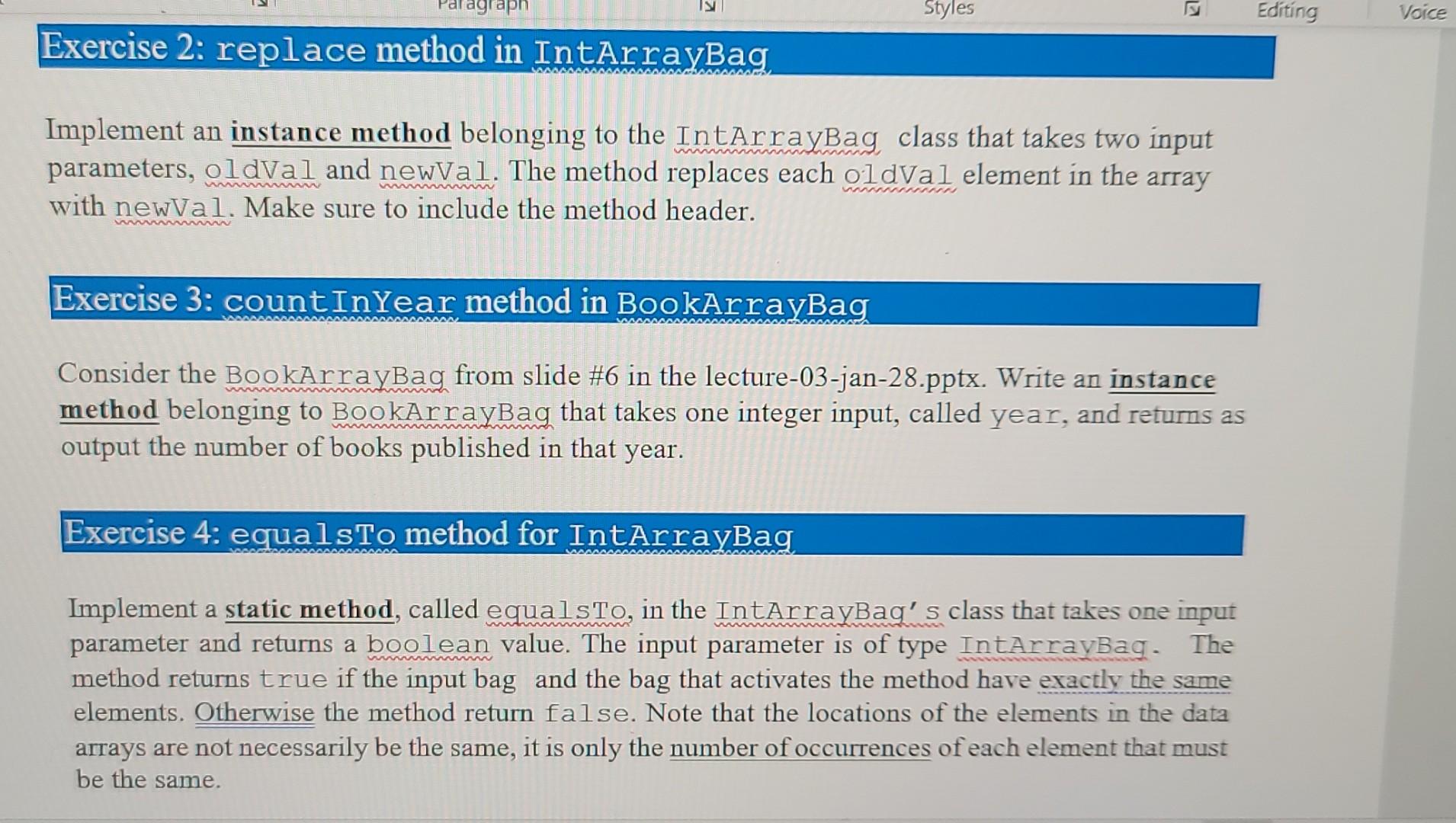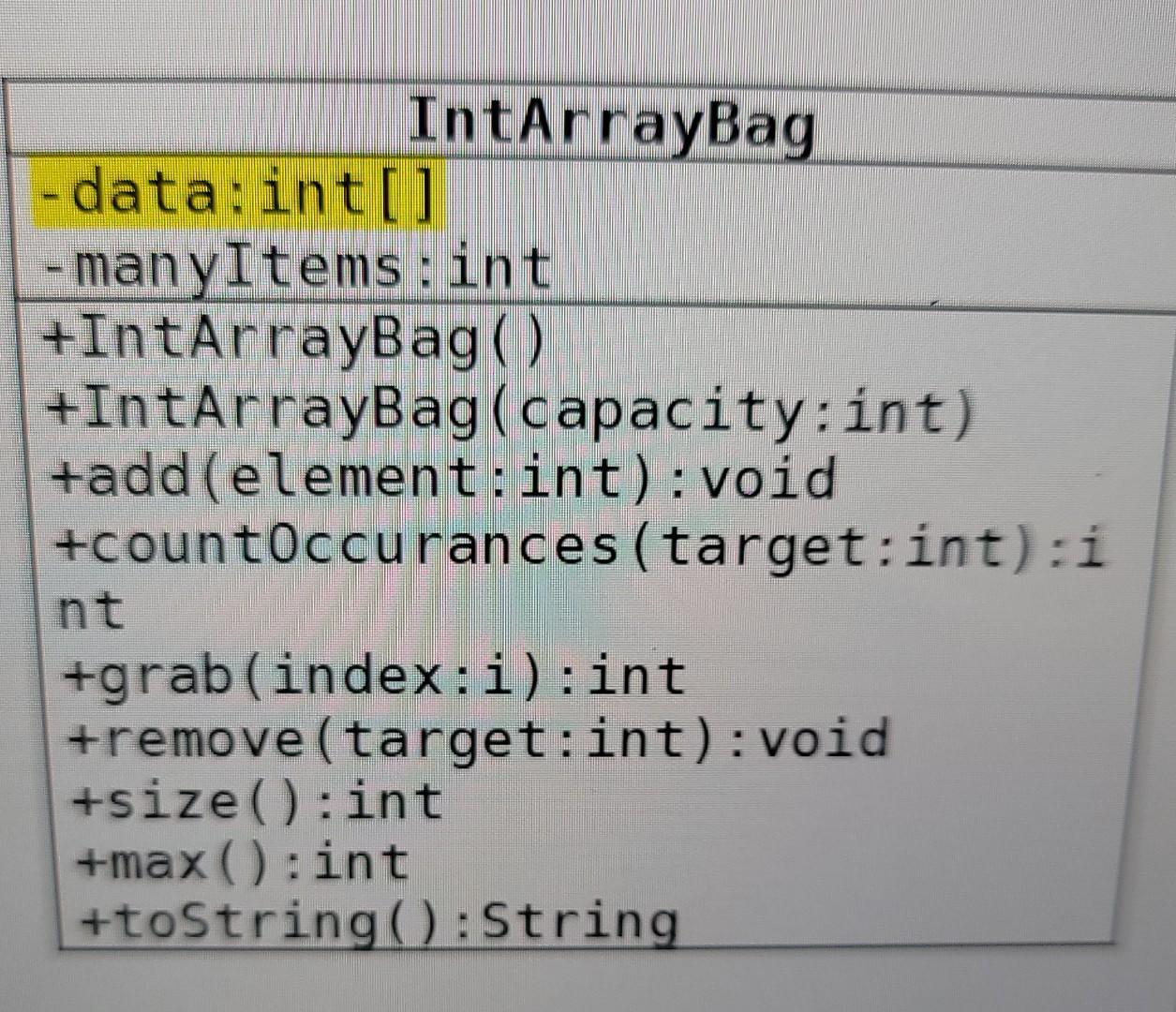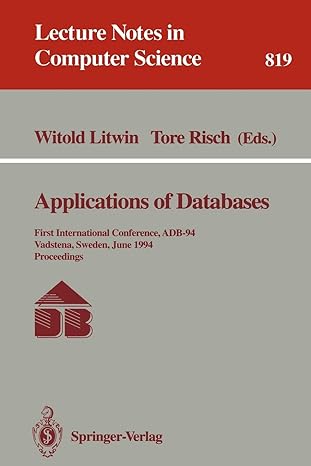Answered step by step
Verified Expert Solution
Question
1 Approved Answer
please help there no other information. Implementing BookArrayBag Book - title : String - year : int + Book ( title : String, year :


please help
there no other information.

Implementing BookArrayBag Book - title : String - year : int + Book ( title : String, year : int) + getTitle(): String + getYear(): int + setTitle ( title : String ) : void + setYear (year : int) : void + equals (obj : Object ): boolean + toString(): String BookArrayBag - data : Book - manyltems : int + BookBag () + BookBag ( capacity : int) + add (b: Book): void + remove (b: Book ) : void + size (): int + grab (index: int) : Book + find (b: Book): Book + countOccurrences (b:Book) : int + toString(): String + max(): Book *Two books are equal when they have the same title (case insensitive). ICS 240-50: Introduction to Data Structures - Spring 2022 Styles Editing Voice Exercise 2: replace method in IntArrayBag Implement an instance method belonging to the IntArrayBag class that takes two input parameters, oldVal and newVal. The method replaces each oldVal element in the array with newVal. Make sure to include the method header. Exercise 3: countInYear method in BookArrayBag Consider the BookArrayBag from slide #6 in the lecture-03-jan-28.pptx. Write an instance method belonging to BookArrayBag that takes one integer input, called year, and returns as output the number of books published in that year. Exercise 4: equalsTo method for IntArrayBag Implement a static method, called equalsTo, in the IntArrayBag's class that takes one input parameter and returns a boolean value. The input parameter is of type IntArrayBag. The method returns true if the input bag and the bag that activates the method have exactly the same elements. Otherwise the method return false. Note that the locations of the elements in the data arrays are not necessarily be the same, it is only the number of occurrences of each element that must be the same. : IntArrayBag - data:int[] - manyItems:int +IntArrayBag() +IntArrayBag(capacity:int) +add(element int):void +countOccurances (target:int): nt +grab (index:i) :int +remove(target:int) : void +size(): int +max(): int +toString(): String Implementing BookArrayBag Book - title : String - year : int + Book ( title : String, year : int) + getTitle(): String + getYear(): int + setTitle ( title : String ) : void + setYear (year : int) : void + equals (obj : Object ): boolean + toString(): String BookArrayBag - data : Book - manyltems : int + BookBag () + BookBag ( capacity : int) + add (b: Book): void + remove (b: Book ) : void + size (): int + grab (index: int) : Book + find (b: Book): Book + countOccurrences (b:Book) : int + toString(): String + max(): Book *Two books are equal when they have the same title (case insensitive). ICS 240-50: Introduction to Data Structures - Spring 2022 Styles Editing Voice Exercise 2: replace method in IntArrayBag Implement an instance method belonging to the IntArrayBag class that takes two input parameters, oldVal and newVal. The method replaces each oldVal element in the array with newVal. Make sure to include the method header. Exercise 3: countInYear method in BookArrayBag Consider the BookArrayBag from slide #6 in the lecture-03-jan-28.pptx. Write an instance method belonging to BookArrayBag that takes one integer input, called year, and returns as output the number of books published in that year. Exercise 4: equalsTo method for IntArrayBag Implement a static method, called equalsTo, in the IntArrayBag's class that takes one input parameter and returns a boolean value. The input parameter is of type IntArrayBag. The method returns true if the input bag and the bag that activates the method have exactly the same elements. Otherwise the method return false. Note that the locations of the elements in the data arrays are not necessarily be the same, it is only the number of occurrences of each element that must be the same. : IntArrayBag - data:int[] - manyItems:int +IntArrayBag() +IntArrayBag(capacity:int) +add(element int):void +countOccurances (target:int): nt +grab (index:i) :int +remove(target:int) : void +size(): int +max(): int +toString(): String
Step by Step Solution
There are 3 Steps involved in it
Step: 1

Get Instant Access to Expert-Tailored Solutions
See step-by-step solutions with expert insights and AI powered tools for academic success
Step: 2

Step: 3

Ace Your Homework with AI
Get the answers you need in no time with our AI-driven, step-by-step assistance
Get Started


